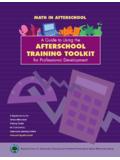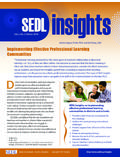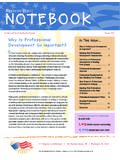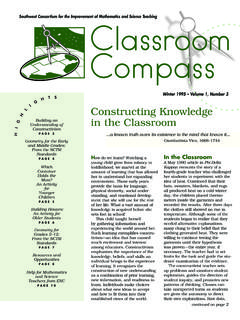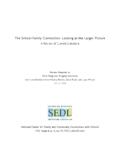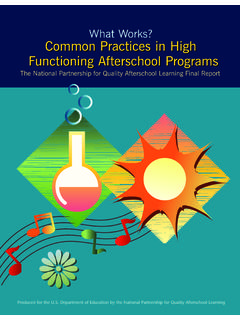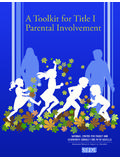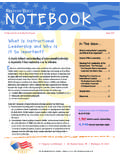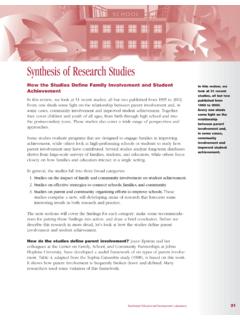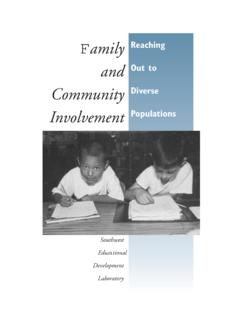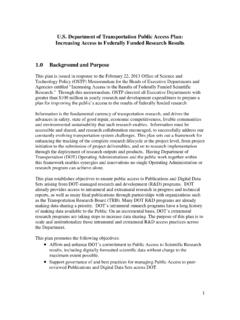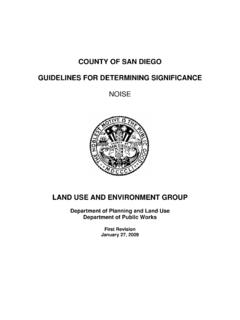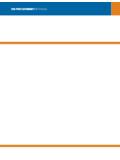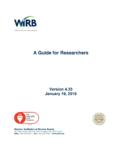Transcription of The Changing Role of the Teacher - AIR | SEDL
1 TheInstructional CoherenceChanging Role of the Teacher September, 2000 Southwest Educational Development Laboratory This publication was produced wholly, or in part, withfunds from the Office of Educational Research andImprovement (OERI), U. S. Department of Education,under contract #RJ96006801. The content herein doesnot necessarily reflect the views of OERI, theDepartment, any other agency of the U. S. Government,or any other source. Instructional Coherence: The Changing Role of theTeacheris a product of the Promoting InstructionalCoherence Project in the Program for the Improvementof Teaching and Learning.
2 This project assists educatorsin constructing a comprehensive approach to teachingand learning. To contact the Promoting InstructionalCoherence Project, please call us at 1-800-476-6861 orwrite to us at SEDL, 211 East Seventh Street, Austin,Texas 78701. You may also send email to StephenMarble, Program Manager, is an Equal Employment Opportunity/AffirmativeAction Employer and is committed to affording equalemployment opportunities for all individuals in allemployment on cover and page 5 PhotoDiscPhotos on pages 2-6, 12, and 18 ComstockPhotos on pages 3, 9, and 11 Eyewire ImagesGraphic Design.
3 Jane ThurmondSouthwest Educational Development Laboratory211 East Seventh StreetAustin, Texas 78701(512) 476-6861 science curriculum guide says to cover electricityand magnetism, but gives little specific guidance forsomeone like Sonia, a second-year Teacher with littlescience background. She has the batteries and bulbsbox (from the district s materials center) and thinksthe hands-on activities and worksheets in the box willbe a good way to start an electricity unit. She directsher students to pair up, get their materials and work-sheets, and work on the tasks outlined on the work-sheets. Most of the students quickly figure out how todo the tasks, and Sonia reminds them to answer thequestions on the worksheet.
4 The students are enjoy-ing the activities. Some visit other groups to see different strategies, and others extend the ideas byusing a metal button or two bulbs. Suddenly, Soniacollects the materials and tells the students to get outtheir science textbooks. They read aloud from thetextbook that uses many scientific terms, and Soniadoes not refer back to the activities. She gives thestudents a reading assignment and questions toanswer for homework. The students were getting noisy, not following theworksheet, and asking questions Sonia felt unpre-pared to answer. She became unsure of what washappening, so she gathered up the materials andwent back to the textbook.
5 Sonia says that the curriculum and standards documents don t reallyhelp her decide how to teach electricity. She knowsshe should use more student-centered hands-onactivities, but she doesn t know how to make it workin her classroom. She is confused and disappointedbecause she knows the lesson was incoherent anddid not help students understand the of ContentsCalls for Reform1 Directions of Change5A Focus on Studentand Teacher Learning11 Conclusion19 References Cited21 Sandra J. Finley, Educational Development LaboratorySeptember, 2000 TheInstructional CoherenceChanging Role of the TeacherThe Changing Role of the Teacherhis is not an uncommon are facing an avalanche of frequently disconnected calls to reform, to dothings differently.
6 The pressure to changepractice may come from many sources at thesame time: state adoption of new studentassessments, school participation in a reformprogram, and advocacy of new teaching strate-gies by a workshop presenter or professionalorganization. The viewpoints of various educational experts about teaching, learning,and classroom practice are often inconsistentor even contradictory. In coming to grips withinnovation and reform, teachers like Sonia arechallenged to understand new theories oflearning, new approaches to teaching, newpolicies, and a Changing social context thataffects students and communities.
7 Some teachers strive to make sense ofboth the inconsistencies and the new ideaswhen they make daily instructional they are successful and create qual-ity learning experiences for their students;sometimes they throw up their hands in frustration. Many other teachers make theirdecisions based on their immediate needs tocomply, survive, conform, or meet a time constraint. They follow the textbook, teach tothe test, give students worksheets to keepthem occupied, or do the same lessons yearafter year. Most teachers follow this easierpathway at least some of the time.
8 However,this path often leads teachers to unintentionallycreate learning environments that are not fulfilling for either students or the the literally thousands of efforts toimprove schools since World War II, few haveThad significant or enduring effects on instruc-tion and student learning (Cohen & Ball,1999). A recent review of federally-fundedresearch suggests that researchers, educators,and reformers now understand that whencurriculum, instructional materials, and assess-ments are all focused on the same goals that is, when the policy systems that frameeducation are coherent the prospects foreducational improvement are enhanced (Koppich & Knapp, 1998, p.)
9 2). However,translating policy coherence into improvedinstructional coherence and student learningseems more elusive and complex than antici-pated. As long as reform ideas continue toconfuse and frustrate teachers, can we expectsignificant and enduring improvement ininstruction and student learning? In this paper, we show that policymakersand researchers have changed their viewsabout school improvement and the role ofteachers in the process. We suggest that edu-cational reform initiatives challenge classroomteachers to make sense of new policies, ideas,programs, and their own work. We also note,however, that teachers should receive morehelp in their efforts as new conceptions ofreform and teachers learning become morepopular.
10 Finally, we propose that supportingteachers in their development of a stancetoward their practice that is focused on learn-ing and learners can promote instructionalcoherence and improved student , we examine six dimensions ofteachers work: knowledge, professionalism,collaboration, instruction, agency, and some teachers may remain isolatedfrom the influence of current schoolimprovement efforts, most probably find it difficult to avoid the issue. Reform is a majortopic at state and national conferences, in professional and popular journals, in work-shops and courses, and on national televisionnews programs.
